This is an AI Free Zone! Text created by ChatGPT and other Large Language Models is spreading rapidly across the Internet. It's well-written, artificial, frequently inaccurate. If you find a mistake on Spaceweather.com, rest assured it was made by a real human being. | | |
A BIG SUNSPOT IS TURNING TOWARD EARTH: It's 200,000 km wide, contains a dozen dark cores, and is crackling with M-class solar flares. Sunspot complex AR3490-91-92 is so big it takes 3 numbers to label it. The active region is turning toward Earth and will pose a threat for Earth-directed flares by mid-week. Solar flare alerts: SMS Text
SPACEX AURORAS: There's a new phenomenon in the night sky: "SpaceX auroras." They're red, roughly spherical, and visible to the naked eye for as much as 10 minutes at a time. "We are seeing 2 to 5 of them each month," reports Stephen Hummel of the McDonald Observatory in Texas, who photographed this example on Nov. 3rd:
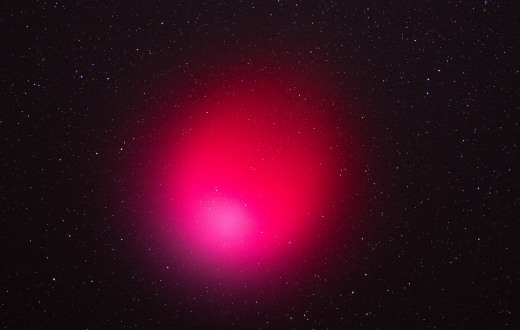
Spoiler alert: They're not auroras. The bright red balls are caused by SpaceX rockets burning their engines in the ionosphere.
The phenomenon is closely related to something we reported earlier this year. Falcon 9 rockets leaving Earth can "punch a hole in the ionosphere." The ionosphere is a layer of ionized gas surrounding our planet; it is crucial to over-the-horizon shortwave radio communication and can affect the quality of GPS signals. Water-filled rocket exhaust can quench local ionization by as much as 70%, erasing the ionosphere along the rocket's path. For reasons having to do with chemistry, ionospheric holes emit a red glow (630 nm).
"SpaceX auroras" are exactly the same--except instead of rockets going up, they are caused by rockets coming down. The second stage of the Falcon 9 rocket burns its engines in order to de-orbit and return to Earth, creating an ionospheric hole as it descends.
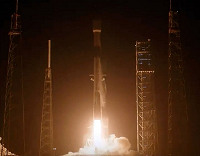 Right: The night launch of this Falcon 9 rocket on Nov. 3, 2023, produced a red glow over McDonald Observatory in Texas.
Right: The night launch of this Falcon 9 rocket on Nov. 3, 2023, produced a red glow over McDonald Observatory in Texas.
"We first noticed these SpaceX de-orbit burns over the McDonald Observatory in February 2023," says Boston University space physicist Jeff Baumgarder, who has been studying ionospheric holes for more than 40 years. "The engine burns are only about 2 seconds long, just enough delta V to bring the second stage down over the south Atlantic Ocean. These burns happen ~90 minutes ( ~one orbital period) after launch. During the burn, the engine releases about 400lbs of exhaust gasses, mostly water and carbon dioxide. All this happens at ~300km altitude, near the peak of the ionosphere, so a significant hole is made."
"The resulting 'auroras' can be very bright, easily visible with the naked eye and much brighter than Starlink satellites themselves, although only for a few seconds," notes Hummel.
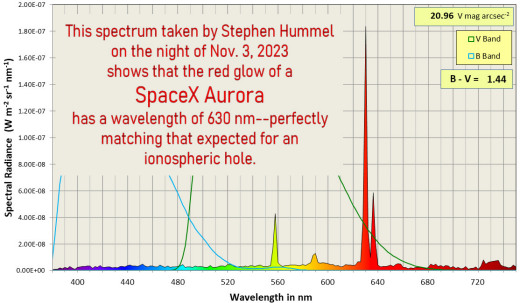
The question is, are SpaceX auroras good or bad? Hummel is the McDonald Observatory Dark Skies Sr. Outreach Program Coordinator, so naturally he's concerned about the effect these events may have on observational astronomy.
"The frequency of these red clouds could increase as SpaceX targets more launches in the future," says Hummel. "Their impact on astronomical science is still being evaluated. Starlink satellites are a known issue, but the effects of the rocket launches themselves are a growing area of attention."
For Jeff Baumgarder, who has his own dedicated camera at McDonald, the events are a golden opportunity for research.
"The saying 'one person's signal is another person's noise' is appropriate here," says Baumgardner. "We are delighted with the rocket burns. They give us an opportunity to explore how space traffic affects the ionosphere. The ionospheric density is different night to night, so we can learn something about the efficiency of the chemistry by observing many events."
Other sky watchers are beginning to see SpaceX auroras as well. Are you one of them? Submit your pictures here.
Realtime Space Weather Photo Gallery
Free: Spaceweather.com Newsletter
WHERE NO ORNAMENT HAS GONE BEFORE: You cannot buy a rare Capt. Kirk space ornament on Amazon. But you can get one from the Earth to Sky Store. On Oct 9, 2022, the students of Earth to Sky Calculus launched Capt. Kirk to the stratosphere onboard a cosmic ray research balloon. Here he is floating 109,620 feet high:
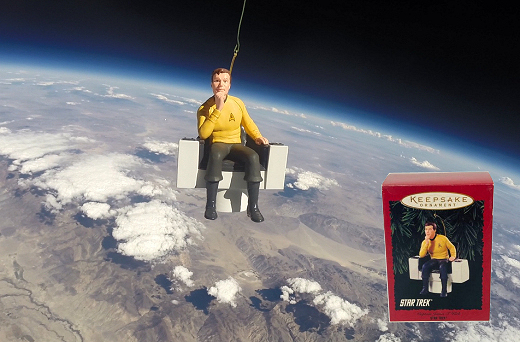
You can have it for $99.95. Made by Hallmark in the 1990s, the ornament comes with a greeting card showing the captain of the Enterprise in flight and telling the story of its trip to the stratosphere and back again.
The students are selling space ornaments to pay the helium bill for their cosmic ray ballooning program. Each one comes with a greeting card showing the item in flight and telling the story of its trip to the stratosphere and back again.
Far Out Gifts: Earth to Sky Store
All sales support hands-on STEM education
Realtime Comet Photo Gallery
Free: Spaceweather.com Newsletter
Realtime Aurora Photo Gallery
Free: Spaceweather.com Newsletter
Every night, a network of
NASA all-sky cameras scans the skies above the United States for meteoritic fireballs. Automated software maintained by NASA's Meteoroid Environment Office calculates their orbits, velocity, penetration depth in Earth's atmosphere and many other characteristics. Daily results are presented here on Spaceweather.com.
On Nov 21, 2023, the network reported 36 fireballs.
(20 sporadics, 12 Leonids, 3 Northern Taurids, 1 omicron Eridanid)
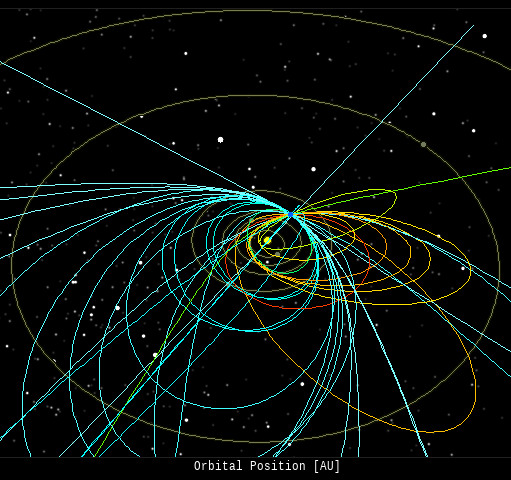
In this diagram of the inner solar system, all of the fireball orbits intersect at a single point--Earth. The orbits are color-coded by velocity, from slow (red) to fast (blue). [Larger image] [movies]
Potentially Hazardous Asteroids (
PHAs) are space rocks larger than approximately 100m that can come closer to Earth than 0.05 AU. None of the known PHAs is on a collision course with our planet, although astronomers are finding
new ones all the time.
On November 21, 2023 there were 2349 potentially hazardous asteroids.
 |
Recent & Upcoming Earth-asteroid encounters: | Asteroid | Date(UT) | Miss Distance | Velocity (km/s) | Diameter (m) |
| 2019 VL5 | 2023-Nov-16 | 8.5 LD | 8.2 | 24 |
| 2023 WA | 2023-Nov-17 | 0.1 LD | 17.9 | 7 |
| 2023 WU | 2023-Nov-17 | 1.9 LD | 9.2 | 13 |
| 2023 VG5 | 2023-Nov-17 | 5.7 LD | 23.3 | 26 |
| 2023 VX4 | 2023-Nov-17 | 7 LD | 3.9 | 11 |
| 2023 VX7 | 2023-Nov-17 | 2.5 LD | 10.8 | 14 |
| 2023 VK4 | 2023-Nov-17 | 12.3 LD | 11.9 | 24 |
| 2023 VR9 | 2023-Nov-17 | 3.3 LD | 7.7 | 11 |
| 2023 VW7 | 2023-Nov-17 | 7.3 LD | 10.1 | 19 |
| 2023 WB | 2023-Nov-18 | 1.7 LD | 12.6 | 17 |
| 2019 LB1 | 2023-Nov-18 | 15.8 LD | 4.2 | 14 |
| 2016 DK1 | 2023-Nov-19 | 5.3 LD | 6.8 | 12 |
| 2023 VY7 | 2023-Nov-19 | 19.7 LD | 13.7 | 78 |
| 2023 VT7 | 2023-Nov-19 | 15 LD | 10.6 | 57 |
| 2022 VR1 | 2023-Nov-19 | 8.1 LD | 6.1 | 39 |
| 2023 VB10 | 2023-Nov-19 | 14.1 LD | 11.3 | 21 |
| 2023 VE7 | 2023-Nov-20 | 14.1 LD | 19.7 | 40 |
| 2023 VE4 | 2023-Nov-20 | 13.3 LD | 11.6 | 38 |
| 2023 VW5 | 2023-Nov-21 | 4.4 LD | 11.2 | 28 |
| 2023 WV | 2023-Nov-22 | 2.3 LD | 14.1 | 15 |
| 2023 WJ1 | 2023-Nov-22 | 11.8 LD | 4.9 | 24 |
| 2023 VC7 | 2023-Nov-23 | 10.6 LD | 8.1 | 24 |
| 2023 VH6 | 2023-Nov-23 | 6.8 LD | 7.3 | 28 |
| 2019 UT6 | 2023-Nov-24 | 9 LD | 13.2 | 141 |
| 2019 CZ2 | 2023-Nov-25 | 2.8 LD | 5.8 | 44 |
| 2023 VH5 | 2023-Nov-25 | 17.9 LD | 9 | 33 |
| 2023 VM1 | 2023-Nov-26 | 10.9 LD | 8.9 | 42 |
| 2013 UB3 | 2023-Nov-27 | 18.5 LD | 5.4 | 25 |
| 2023 WE1 | 2023-Nov-28 | 7.8 LD | 13 | 16 |
| 2023 VR5 | 2023-Nov-28 | 5.3 LD | 3 | 11 |
| 2023 VY8 | 2023-Nov-29 | 17 LD | 19.8 | 29 |
| 2023 WC1 | 2023-Nov-30 | 5.7 LD | 7.8 | 20 |
| 2023 VM7 | 2023-Dec-01 | 6.4 LD | 3.2 | 11 |
| 1998 WB2 | 2023-Dec-03 | 11 LD | 14.2 | 151 |
| 2013 VX4 | 2023-Dec-04 | 5.1 LD | 6.6 | 60 |
| 2023 WW | 2023-Dec-05 | 7.8 LD | 8.5 | 43 |
| 2023 TB27 | 2023-Dec-06 | 17 LD | 4.3 | 44 |
| 139622 | 2023-Dec-06 | 14.4 LD | 6.7 | 719 |
| 2023 VF12 | 2023-Dec-08 | 13 LD | 4.1 | 22 |
| 2023 WG | 2023-Dec-08 | 17.6 LD | 6.6 | 38 |
| 2023 WH | 2023-Dec-10 | 11.9 LD | 8.9 | 40 |
| 2020 HX3 | 2023-Dec-10 | 9.8 LD | 15.7 | 13 |
| 2010 XF3 | 2023-Dec-11 | 19.4 LD | 4 | 46 |
| 2016 XD2 | 2023-Dec-19 | 18.7 LD | 6.9 | 59 |
| 341843 | 2023-Dec-20 | 16.5 LD | 5.3 | 344 |
| 2018 YJ2 | 2023-Dec-21 | 18.4 LD | 13.1 | 154 |
| 2022 YG | 2023-Dec-22 | 10.8 LD | 5.1 | 17 |
| 2023 VD6 | 2023-Dec-23 | 10.6 LD | 15.5 | 154 |
| 2020 YO3 | 2023-Dec-23 | 3.6 LD | 16.6 | 42 |
| 2010 UE51 | 2023-Dec-24 | 9 LD | 1.3 | 7 |
| 2020 YR2 | 2023-Dec-25 | 13.8 LD | 8 | 8 |
| 2021 AM6 | 2023-Dec-31 | 18.3 LD | 6.6 | 17 |
| 2019 KK5 | 2024-Jan-03 | 10.6 LD | 20.9 | 98 |
| 2002 AY1 | 2024-Jan-08 | 15.2 LD | 17.3 | 230 |
| 2020 AC1 | 2024-Jan-11 | 19.3 LD | 5.3 | 7 |
| 2021 CZ2 | 2024-Jan-16 | 8 LD | 14.3 | 113 |
Notes: LD means "Lunar Distance." 1 LD = 384,401 km, the distance between Earth and the Moon. 1 LD also equals 0.00256 AU. | | Cosmic Rays in the Atmosphere |
SPACE WEATHER BALLOON DATA: Almost once a week, Spaceweather.com and the students of Earth to Sky Calculus fly space weather balloons to the stratosphere over California. These balloons are equipped with sensors that detect secondary cosmic rays, a form of radiation from space that can penetrate all the way down to Earth's surface. Our monitoring program has been underway without interruption for 7 years, resulting in a unique dataset of in situ atmospheric measurements.
Latest results (July 2022): Atmospheric radiation is decreasing in 2022. Our latest measurements in July 2022 registered a 6-year low:
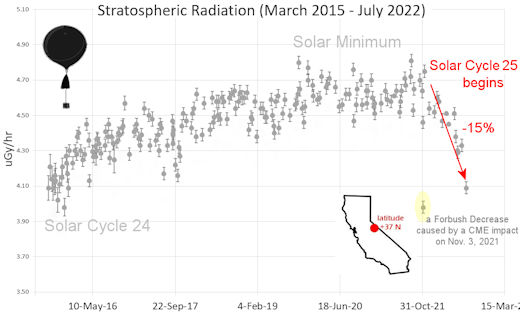
What's going on? Ironically, the radiation drop is caused by increasing solar activity. Solar Cycle 25 has roared to life faster than forecasters expected. The sun's strengthening and increasingly tangled magnetic field repels cosmic rays from deep space. In addition, solar coronal mass ejections (CMEs) sweep aside cosmic rays, causing sharp reductions called "Forbush Decreases." The two effects blend together to bring daily radiation levels down.
.Who cares? Cosmic rays are a surprisingly "down to Earth" form of space weather. They can alter the chemistry of the atmosphere, trigger lightning, and penetrate commercial airplanes. According to a study from the Harvard T.H. Chan school of public health, crews of aircraft have higher rates of cancer than the general population. The researchers listed cosmic rays, irregular sleep habits, and chemical contaminants as leading risk factors. A number of controversial studies (#1, #2, #3, #4) go even further, linking cosmic rays with cardiac arrhythmias and sudden cardiac death.
Technical notes: The radiation sensors onboard our helium balloons detect X-rays and gamma-rays in the energy range 10 keV to 20 MeV. These energies span the range of medical X-ray machines and airport security scanners.
Data points in the graph labeled "Stratospheric Radiation" correspond to the peak of the Regener-Pfotzer maximum, which lies about 67,000 feet above central California. When cosmic rays crash into Earth's atmosphere, they produce a spray of secondary particles that is most intense at the entrance to the stratosphere. Physicists Eric Regener and Georg Pfotzer discovered the maximum using balloons in the 1930s and it is what we are measuring today.
| | The official U.S. government space weather bureau |
| | The first place to look for information about sundogs, pillars, rainbows and related phenomena. |
| | Researchers call it a "Hubble for the sun." SDO is the most advanced solar observatory ever. |
| | 3D views of the sun from NASA's Solar and Terrestrial Relations Observatory |
| | Realtime and archival images of the Sun from SOHO. |
| | information about sunspots based on the latest NOAA/USAF Active Region Summary |
| | current counts of failed and deployed Starlink satellites from Jonathan's Space Page |
| | Authoritative predictions of space junk and satellite re-entries |
| | from the NOAA Space Environment Center |
| | fun to read, but should be taken with a grain of salt! Forecasts looking ahead more than a few days are often wrong. |
| | from the NOAA Space Environment Center |
| | the underlying science of space weather |
 | When looking for casinos to play online when the weather is bad, you can try casino online trucchi for Italian games. If you are not from Finland you can try the Swedish page Svenska casino online to find suitable games, check out svenskacasinoonline.net. Always check your local laws before playing with real money. |
 | BestCSGOGambling is the best site for everything related to CSGO gambling on the web |
| | These links help Spaceweather.com stay online. Thank you to our supporters! |
| | | | | | |

